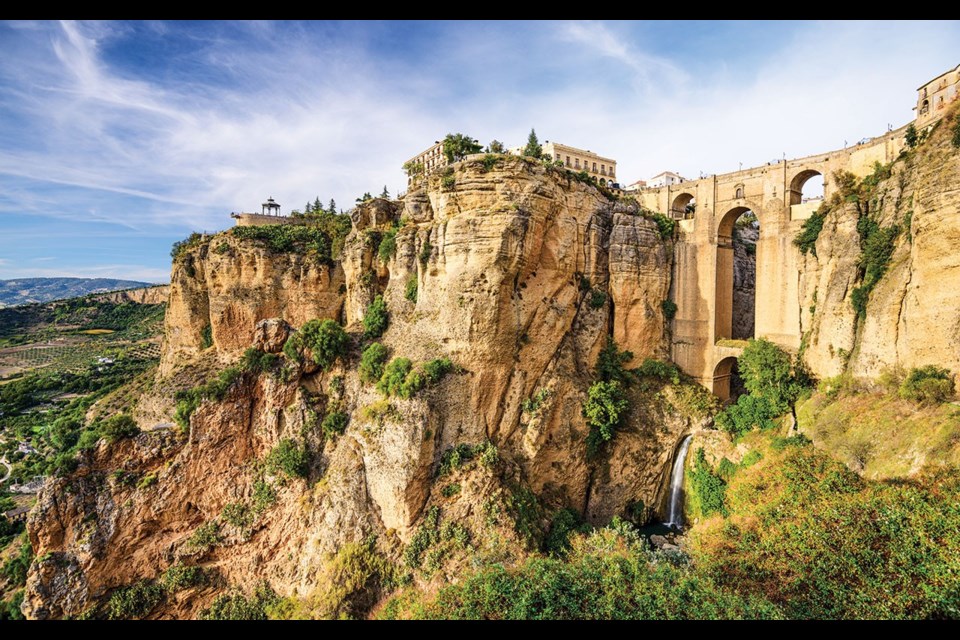I climb steadily, back and forth on the buttressed switchbacks up the mountain, the sun hot on my back and the landscape a soft, beige blur of baked earth and the dusty green of olive trees.
But on every other curve, I see a shock of cyan in the lake etched in the ground far below.
Best of all, when my husband and I reach our destination, we enter the picturesque Pueblos Blancos, which gleam so white they seem like an architectural mirage. Awash in Moorish charm, these pristine towns are distinguished by their simple whitewashed houses built in clusters that cling to mountains or nestle in valleys. The architecture derives its influence from North Africa (present-day Algeria and Morocco), the Moors' native land.
With the famous cities of Seville, Granada and Cordoba hogging the limelight, these small villages aren't typically part of a traveller's tour of Andalusia. But they offer myriad opportunities for cycling and historical exploration and practically demand the clicking of the camera shutter (or, yes, the iPhone equivalent).
My husband has plotted some crazy rides up steep inclines in the tire tracks of the Vuelta, the Spanish Grand Tour (that country's version of Tour de France). Being a strong cyclist but not a masochist, I leave him to tackle the most gruelling climbs solo. For example, the infamous Sierra de la Pandera route, which involves 1,200 metres of elevation—with grades of up to 24 per cent—and ends with a torturous 800-m climb in the last eight kilometres.
I cycle with my husband on the less-gnarly but still ambitious rides. One route takes us through the sun-soaked towns of Grazelema, with charming grey stone streets and windowsills endowed with pots of brilliant flowers, and Zahara, where the ruins of an ancient fortress loom overhead.
We climb 1,000 m in 42 kilometres and I delight in the sharp Spanish fir-scented air and amazing views until I hit the hairpin descents and have to focus on my bike handling.
At one point we are stopped by police; there is a half-Ironman in progress and we marvel at the triathletes, who face 3,050 m of climbing on the 90-km bike and another 460 m on the run. To put this into context, the Ironman bike route at Whistler (considered a hilly course) was a "mere" 2,000 m of climbing spread over twice the distance.
The lack of traffic makes cycling here a joy; though we do stop a time or two for herds of goats and sheep—they tend to hog the road. We are in the middle of the 52,000-hectare Sierra de Grazalema Natural Park, which became Spain's first UNESCO biosphere reserve in 1977, and there are few people about. Soaring peaks give way to semi-deciduous forests and grassy meadows. There are dozens of hiking trails here, beloved by locals and, apparently, not yet discovered by tourists.
This dramatic landscape is what makes Ronda particularly photographic, and one of the most famous of the white towns. On one side is the circa-15th-century "new" town El Mercadillo and on the other is the old Moorish part of town. We wander back and forth across Puente Nuevo, a stone bridge spanning the gorge, completed in 1793 after 42 years of construction.
This is one place that is packed with tourists.
There are a dozen or so white villages, each has a unique charm. I fall in love with Arcos de la Frontera, set on a rocky limestone ridge and boasting exceptional architecture that conveys the transition from gothic to renaissance styles. Two cathedrals here competed for centuries to be named "most important"—Basílica de Santa María and Iglesia de San Pedro. In 1775, the Vatican made the decision that the older of the two, Santa María, was the senior cathedral.
Given the topic is religion, I have a confession to make: my favourite village is not one of the official white ones. It is Antequera, a medieval town in the hills further east, overlooked by an Alcazaba.
This city has a fascinating history, which is evidenced by a profusion of archaeological and architectural legacies: burial mounds, dolmens (table-like tombs), Roman baths, gothic churches, renaissance fountains, baroque bell towers and the aforementioned Moorish castle. It's no wonder it's a World Heritage Site.
It's also where we discover our favorite restaurant, Meson Adarve. We go first for lunch and let the owner bring what he thinks is best today: fresh tuna and tomato salad drizzled in olive oil; succulent octopus; a variety of croquettes (ham, beef, cod); and grilled eggplant covered in Iberian ham. There is also a lovely rose on offer.
The food is wonderful and the owner, his wife the chef and their son our server so delightful that we make a reservation for dinner the following evening, when we again consume a plethora of simple and delectable local dishes.
Andalusia is truly a treasure trove of spectacular landscapes and enticing villages. Not to mention epic rides.
This is the second of Virginia's three travel stories from Andalusia. Find the first at www.piquenewsmagazine.com, Feb. 16, "Awesome Andalusia—Granada, a city seeped in intrigue and home to Spain's most famous fortress."




